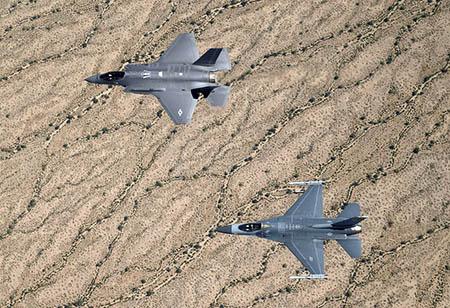The five pages of the report of that test would have come into possession of the 'War is Boring' site which immediately redefined the F-35 as 'dead meat'. The report would not be classified, but considered "for official use only."
We repeat: this news has not been confirmed, but considering the echo that it is having in the world, we have also preferred to tell the alleged expressions of the test pilot, remaining with the benefit of the doubt up to an official stance.
Even if it were a fake, the report is full of details that still instill suspicion. The test would take place on the 14 last January, in the Test Range above the Pacific Ocean, near the base of Edwards, in California.
An F-35A with the designation "AF-02", one of the first JSFs delivered to the Air Force, would have taken off paired with an F-16D Block 40. also the F-35. A sort of passing of the baton in a test that would have seen the past and the future oppose. The two pilots would only have to face each other in close combat at high angles of attack, in defensive and offensive maneuvers ranging from 16 to 10.000 feet.
The F-35 would have been in a clean configuration, with the weapons contained in its bomb compartment and with no tank under its wings. The F-16, on the other hand, would have faced the fifth generation super fighter with two bulky sub-wing tanks, placing it already at a dynamic disadvantage.
That advantage - according to the American website - has in no way helped the F-35. Even with the limited configuration of the F-16, the F-35A would not have been able to bring it down, lacking power in the decommitments.
"That five-page report massacres the entire aerodynamic concept of the F-35."
The pilot would have indicated the most critical issues: "Insufficient pitch rate". "Energy deficit to the bandit would increase over time". "The flying qualities in the blended region (20 - 26 degrees AoA) were not intuitive or favorable". It would mean that the F-35 would never have had the energy and power needed, therefore speed, to frame the enemy, follow it or dodge its attacks in elusive maneuvers.
The pilot would have written: "God help you if the enemy should surprise you, because you have no chance of escape".
The JSF would also have won a duel with the F-16, carrying out excessive and dangerous angles of attack after violent yaw ". However, this maneuver requires power. Energy that the fighter loses once the attack is executed making it vulnerable. The pilot, therefore, after the attack should leave the operating area to regain power.
Also according to the test pilot's report, the 400 thousand dollar helmet is too bulky for the narrow F-35 cockpit. In a close encounter, the F-35 pilot would not be able to turn his head. The F-16, according to the report, would have hidden behind the F-35 and the pilot would not have seen it with his physical eyes.
The F-35, they conclude from the site, is patently inferior in a close combat with the F-16, which the Air Force acquired at the end of the 1970.
The news is now in the public domain. We just have to wait for the official Pentagon and Lockheed Martin note.
Franco Iacch

(photo: US Air Force)












